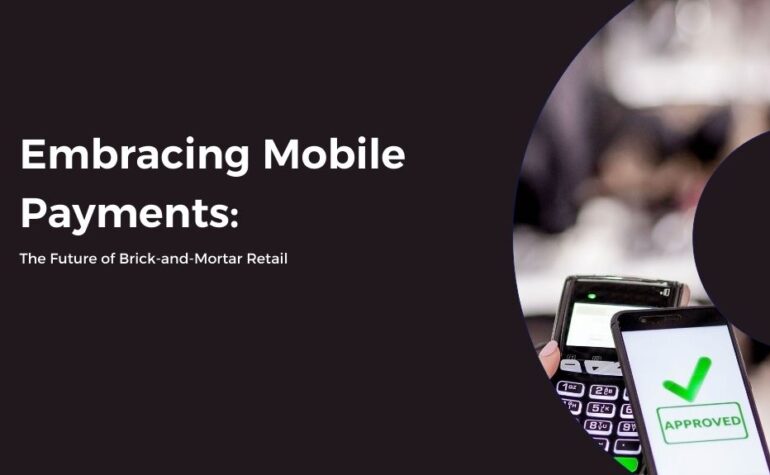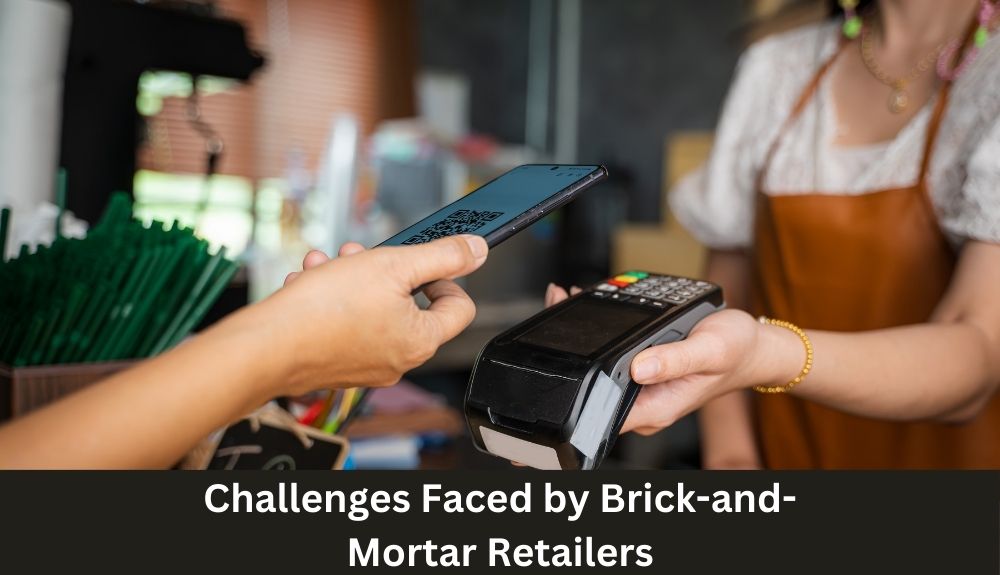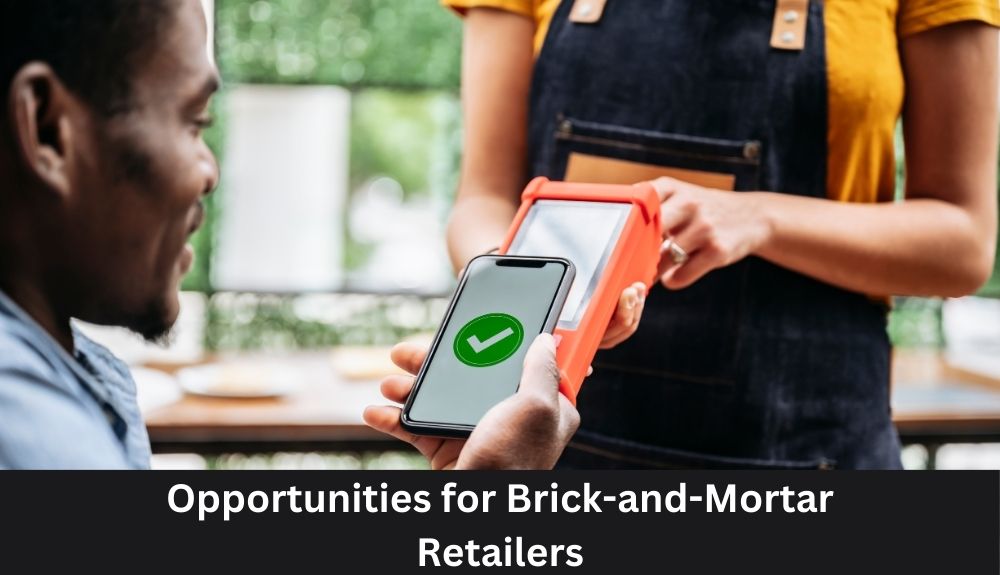Best Credit Card Processing Solutions Tailored for Every Industry

By merchantservices February 8, 2024
In today’s ever-evolving digital landscape, brick-and-mortar retailers face the challenge of staying relevant and competitive. With the rise of mobile technology, embracing mobile payments has become a necessity rather than a choice. But what exactly does the future hold for traditional retailers in the digital age? How can mobile payments revolutionize the way consumer transactions occur in physical stores? This blog delves into the world of mobile payments and explores the tremendous potential they offer to brick-and-mortar businesses.
Imagine a scenario where customers can make purchases with a simple tap on their smartphones, avoiding the hassle of carrying physical cash or credit cards. Mobile payments not only provide a convenient and seamless way for consumers to make transactions, but they also offer a wealth of data-driven insights into consumers’ shopping behavior. By integrating mobile payment systems into their operations, traditional retailers can unlock a world of opportunities, from creating personalized customer experiences to driving customer engagement and loyalty.
In this in-depth exploration, we will discuss the numerous advantages of adopting mobile payment systems and highlight real-world examples of successful implementation. Discover how mobile payments can transform the way you do business, providing a competitive edge in the digital reality of brick-and-mortar retail. Stay ahead of the curve and explore the future of mobile payments in this ever-evolving financial technology landscape.
Introduction to Mobile Payments for Brick-and-Mortar Businesses
Mobile payments have emerged as a game-changer for brick-and-mortar businesses in the ever-evolving digital landscape. As traditional retailers adapt to the changing consumer behaviors and expectations, embracing mobile payment systems has become essential to stay competitive and drive growth.
The rise of mobile technology and the proliferation of smartphones have transformed the way consumers interact with businesses. Today, customers seek seamless and convenient payment methods that enhance their overall shopping experience. Mobile payments provide the perfect solution by offering customers the flexibility to pay securely and conveniently using their mobile devices.
For brick-and-mortar retailers, the benefits of adopting mobile payment systems are multi-fold. Firstly, mobile payments enable businesses to create a more personalized and frictionless customer experience. With mobile wallets and digital payment methods, customers can make transactions quickly and easily, reducing the need for cash or physical cards.
Additionally, mobile payments offer enhanced security features, protecting both customers and businesses from potential fraud and data breaches. By implementing mobile payment systems, traditional retailers can provide their customers with a secure and reliable payment option, building trust and loyalty.
Furthermore, embracing mobile payments opens up opportunities for targeted marketing and customer engagement. By integrating mobile payment apps with loyalty programs and customer data, retailers can gain valuable insights into consumer behaviors and preferences. This data-driven approach allows businesses to offer personalized promotions, discounts, and rewards, ultimately driving customer satisfaction and loyalty.
In summary, mobile payments have become an essential tool for brick-and-mortar businesses to thrive in the digital age. By adopting mobile payment systems, traditional retailers can enhance customer experiences, improve security, and leverage data-driven insights to stay ahead of the curve. In the following sections, we will explore the challenges faced by brick-and-mortar retailers in this transition and the opportunities that mobile payments bring for their growth and success.
Challenges Faced by Brick-and-Mortar Retailers

Traditional retailers face several challenges when adopting mobile payment systems. These challenges can impact their ability to successfully integrate mobile payments into their operations and provide a seamless experience for customers. Understanding these challenges is crucial for brick-and-mortar businesses to overcome them and fully leverage the benefits of mobile payments.
Showrooming: A Digital Threat
Showrooming, where customers visit a physical store to examine products but make their purchases online, has become a growing concern for brick-and-mortar retailers. With the rise of mobile technology, customers can easily compare prices, read reviews, and make informed decisions while they are still in-store. This trend poses a significant challenge for retailers who need to find ways to engage customers and make their in-store experience more appealing than online alternatives.
Inventory Management and Integration
Integrating mobile payment systems into existing inventory management processes can be complex. Retailers need to ensure that their in-store inventory information is accurate and updated in real-time across all channels. This requires seamless integration between mobile payment platforms, point-of-sale systems, and inventory management software. Failure to manage inventory effectively can result in disappointed customers due to inaccurate stock availability information or overselling of products.
Showcasing Value in the Digital Age
Brick-and-mortar retailers must find innovative ways to showcase their value proposition in an increasingly digital marketplace. With the convenience and endless options provided by online platforms, traditional retailers need to differentiate themselves and offer unique in-store experiences. This can be challenging when competing against the lower prices and wider product selection offered by online competitors. To succeed, retailers must leverage mobile payment systems to enhance customer engagement, create personalized experiences, and provide outstanding customer service.
Security and Trust Concerns
While mobile payment systems offer convenience, there are concerns about the security and trustworthiness of these platforms. Customers may hesitate to use mobile payments due to fears of data breaches or unauthorized transactions. Retailers need to address these concerns by implementing robust security measures, providing clear information about the safety of their mobile payment systems, and fostering trust with their customers.
Overall, these challenges highlight the need for brick-and-mortar retailers to adapt and embrace mobile payment systems effectively. By addressing showrooming, streamlining inventory management, showcasing unique value, and ensuring security and trust, traditional retailers can navigate the digital landscape and reap the benefits of mobile payments.
Embracing Mobile Technology
In today’s ever-evolving digital landscape, brick-and-mortar retailers need to adapt to changing consumer behavior and embrace mobile technology to stay competitive. Mobile apps, augmented reality (AR), virtual reality (VR) experiences, and mobile payments present unique opportunities for traditional retailers to enhance customer experiences and drive growth. Let’s explore how these technologies can revolutionize the brick-and-mortar retail industry.
Mobile Apps: Enhancing Customer Engagement
Mobile apps have become a powerful tool for retailers to connect with their customers. By developing their own mobile apps, brick-and-mortar stores can provide a seamless user experience that merges the online and offline shopping worlds. These apps offer features such as personalized recommendations, real-time inventory information, and exclusive offers.
For instance, a clothing store could use its mobile app to send personalized notifications about new arrivals or limited-time discounts based on customers’ preferences and past purchases. By leveraging mobile apps, retailers can cultivate customer loyalty and drive repeat visits to their physical stores.
Augmented and Virtual Reality: Transforming the Shopping Experience
AR and VR technologies have the potential to revolutionize the way consumers interact with physical retail spaces. By integrating these immersive experiences into their stores, traditional retailers can provide unique in-store experiences that attract and engage customers.
For example, a furniture store could use augmented reality to allow customers to visualize how different pieces of furniture would look in their own homes. By simply pointing their smartphones at an empty space, customers can see virtual furniture placed in real-time, eliminating the need for guesswork and providing a more convenient and personalized shopping experience.
Mobile Payments: Convenience and Security
Mobile payments have become increasingly popular due to their convenience and security. By accepting mobile payment methods, brick-and-mortar retailers can offer customers a quick and hassle-free checkout experience. With just a few taps on their mobile devices, customers can securely complete their purchases, eliminating the need to carry physical cash or credit cards.
Furthermore, mobile payments provide retailers with a wealth of data-driven insights. By analyzing transaction data, retailers can gain a better understanding of their customers’ shopping behavior, preferences, and purchasing patterns. This valuable information can be used to personalize marketing strategies, optimize inventory management, and enhance overall business operations.
In conclusion, embracing mobile technology presents numerous opportunities for brick-and-mortar retailers. By developing mobile apps, incorporating AR and VR experiences, and accepting mobile payments, traditional retailers can create unique and immersive customer experiences, drive growth, and stay competitive in the digital age. It is essential for retailers to adapt and harness the power of mobile technology to thrive in the ever-changing retail landscape.
Opportunities for Brick-and-Mortar Retailers

Mobile payments have revolutionized the way consumers interact with brick-and-mortar retailers, opening up a world of exciting opportunities for businesses to enhance customer experiences and drive growth. By embracing mobile payment systems, traditional retailers can tap into a range of advantages that help them stay competitive in the ever-evolving digital landscape.
Click-and-Collect Services
One of the significant opportunities offered by mobile payments is the integration of click-and-collect services. This allows customers to make purchases online and pick them up in-store, bridging the gap between the digital and physical shopping experience. By implementing this convenient service, retailers can attract more customers who value the ease and flexibility of shopping online while enjoying the immediacy of in-store collection.
Personalized Experiences
Mobile payments enable retailers to gather valuable data about customer preferences and behaviors. With this wealth of information, brick-and-mortar stores can create personalized experiences that prioritize individual needs. By utilizing customer data, retailers can offer tailored recommendations, discounts, and rewards, fostering stronger customer loyalty and satisfaction.
Data-Driven Insights
The promise of outstanding data-driven insights is a game-changer for brick-and-mortar retailers. Mobile payment systems allow for the real-time collection of crucial information, such as purchase history, shopping patterns, and customer demographics. By leveraging this data, businesses can gain a deeper understanding of their customers’ preferences and needs, enabling them to make more informed decisions about merchandising, marketing strategies, and inventory management.
Enhanced Customer Engagement
Mobile payments create opportunities for enhanced customer engagement through the integration of mobile apps and loyalty programs. Retailers can develop their own mobile apps, offering exclusive deals, personalized offers, and easy payment options. This not only improves convenience for customers but also provides a platform for ongoing communication and engagement. By nurturing these connections, brick-and-mortar retailers can build long-lasting relationships with their customers and create a unique in-store experience.
Competitive Advantage
In today’s digital marketplace, brick-and-mortar retailers face significant competition from online platforms. Mobile payments provide a powerful tool for staying competitive by offering a seamless and convenient payment method for customers. By embracing this technology, retail businesses can match the ease and speed of online transactions while leveraging the unique strengths of the physical store environment, such as the ability to provide hands-on product experiences and face-to-face customer interactions.
Conclusion
The opportunities presented by mobile payments for brick-and-mortar retailers are vast and varied. From click-and-collect services and personalized experiences to data-driven insights and enhanced customer engagement, embracing this technology is essential for staying relevant and thriving in the digital age. By leveraging the unique advantages of mobile payments, traditional retailers can create a seamless and integrated shopping experience that combines the best of both the physical and digital worlds.
Remember, to make the most of these opportunities, brick-and-mortar retailers must ensure they have robust and secure mobile payment systems in place, giving customers the confidence to embrace this convenient way of transacting. By embracing mobile payments and adapting to the ever-evolving financial technology landscape, traditional retailers can position themselves as forward-thinking innovators, ready to meet the needs of today’s mobile-focused consumers.
Conclusion
In conclusion, embracing mobile payments is crucial for brick-and-mortar businesses to thrive in the digital age. By integrating mobile payment systems, traditional retailers can unlock a multitude of benefits and stay competitive in the ever-evolving retail landscape.
Mobile payments offer convenience and ease-of-use for customers, enhancing their overall shopping experience. With the proliferation of smartphones and the rise of mobile technology, consumers increasingly prefer the convenience of digital payment methods over traditional cash or credit card transactions. By providing mobile payment options, brick-and-mortar retailers can cater to this shifting consumer behavior and meet the expectations of modern shoppers.
Moreover, mobile payments enable retailers to gather valuable data-driven insights. By integrating mobile payment systems with their in-store operations, retailers can capture real-time inventory information, track customer preferences, and analyze shopping patterns. This wealth of data empowers retailers to make informed business decisions, personalize customer experiences, and implement targeted marketing strategies.
Furthermore, embracing mobile payments allows brick-and-mortar retailers to bridge the gap between their physical stores and the digital realm. By leveraging mobile apps, augmented reality (AR), and virtual reality (VR) experiences, retailers can create unique in-store experiences that differentiate themselves from online competitors. These innovative technologies provide opportunities for interactive product displays, virtual try-ons, and immersive shopping experiences that attract and engage customers.
To stay ahead in the digital age, brick-and-mortar retailers must recognize the importance of mobile payments as a powerful tool for customer engagement, data-driven insights, and seamless integration of online and offline experiences. By embracing mobile payment solutions, traditional retailers can not only adapt to changing consumer expectations but also capitalize on the opportunities presented by mobile commerce. The future of brick-and-mortar retail lies in embracing mobile payments and leveraging the benefits they bring. Stay ahead, embrace mobile payments, and secure a prosperous future for your business.
Leave a Reply